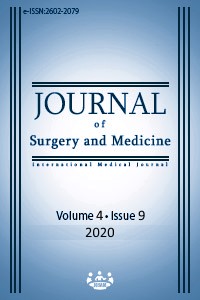Relationship between Syntax I - Syntax II and Spielberger State-Trait Anxiety Inventory in stable angina pectoris patients
Keywords:
Syntax-I, Syntax-II, Spielberger State-Trait Anxiety Inventory, stable anginapectorisAbstract
Aim: State-trait anxiety inventory (STAI) is a parameter used to measure anxiety levels. SYNTAX score is an anatomically based scoring system used to determine the complexity of coronary artery disease (CAD). We investigated the relationship between SYNTAX-I, SYNTAX-II scores, and STAI. Methods: A questionnaire-based cross-sectional study was conducted on 150 consecutive patients (54 female and 96 male) who presented to our hospital with the diagnosis of stable angina pectoris and underwent elective coronary angiography (CAG). Patients answered the STAI questionnaire at least 1 hour prior to elective CAG. Assessment of the cineangiographic images was performed by two experienced cardiologists blinded to the study data. Results: The evaluation of Spearman's Rho correlation coefficients revealed a significant, strong, and positive relationship between STAI score and SYNTAX I (r=0.757, P<0.001), as well as SYNTAX II (r=0.811, P<0.001). SYNTAX I and SYNTAX II scores were also significantly positively correlated (r=0.681, P<0.001). Conclusion: We found a strong and significant correlation between SYNTAX I, SYNTAX II and STAI score variables. STAI score level is an independent and strong predictor of SYNTAX score and can be used a pretest indicator to identify patients with CAD.
Downloads
References
Laslett LJ, Alagona P Jr, Clark BA 3rd, Drozda JP Jr, Saldivar F, Wilson SR, et al. The worldwide environment of cardiovascular disease: prevalence, diagnosis, therapy, and policy issues: a report from the American College of Cardiology. J Am Coll Cardiol. 2012 Dec 25;60(25 Suppl):S1-49. doi: 10.1016/j.jacc.2012.11.002.
Roth GA, Huffman MD, Moran AE, Feigin V, Mensah GA, Naghavi M, et al. Global and regional patterns in cardiovascular mortality from 1990 to 2013. Circulation. 2015 Oct 27;132(17):1667-78. doi: 10.1161
Rosamond W, Flegal K, Furie K, Go A, Greenlund K, Haase N, et al. American Heart Association Statistics Committee and Stroke Statistics Subcommittee. Heart disease and stroke statistics--2008 update: a report from the American Heart Association Statistics Committee and Stroke Statistics Subcommittee. Circulation. 2008 Jan 29;117(4):e25-146. doi: 10.1161/CIRCULATIONAHA.107.187998
Nichols M, Townsend N, Scarborough P, Rayner M. Cardiovascular disease in Europe 2014: epidemiological update. Eur Heart J. 2014 Nov 7;35(42):2950-9. doi: 10.1093/eurheartj/ehu299.
Benjamin EJ, Virani SS, Callaway CW, Chamberlain AM, Chang AR, Cheng S, et al. American Heart Association Council on Epidemiology and Prevention Statistics Committee and Stroke Statistics Subcommittee. Heart Disease and Stroke Statistics-2018 Update: A Report From the American Heart Association. Circulation. 2018 Mar 20;137(12):e67-e492. doi: 10.1161/CIR.0000000000000558.
Caldwell PH, Arthur HM, Natarajan M, Anand SS. Fears and beliefs of patients regarding cardiac catheterization. Soc Sci Med. 2007 Sep;65(5):1038-48. doi: 10.1016/j.socscimed.2007.04.010.
De Jong-Watt WJ, Arthur HM. Anxiety and health-related quality of life in patients awaiting elective coronary angiography. Heart Lung. 2004 Jul-Aug;33(4):237-48. doi: 10.1016/j.hrtlng.2004.03.006.
Heikkilä J, Paunonen M, Laippala P, Virtanen V. Nurses' ability to perceive patients' fears related to coronary arteriography. J Adv Nurs. 1998 Dec;28(6):1225-35. doi: 10.1046/j.1365-2648.1998.00852.x.
Guzzetta CE. Relationship between stress and learning. ANS Adv Nurs Sci. 1979 Jul;1(4):35-49. doi: 10.1097/00012272-197907000-00004.
Nyamathi A, Kashiwabara A. Preoperative anxiety. Its affect on cognitive thinking. AORN J. 1988 Jan;47(1):164-70. doi: 10.1016/s0001-2092(07)70065-0.
Pedrabissi L, Rolland JP, Santinello M. Stress and burnout among teachers in Italy and France. J Psychol. 1993 Sep;127(5):529-35. doi: 10.1080/00223980.1993.9914889.
Rutledge T, Kenkre TS, Bittner V, Krantz DS, Thompson DV, Linke SE, et al. Anxiety associations with cardiac symptoms, angiographic disease severity, and healthcare utilization: the NHLBI-sponsored Women's Ischemia Syndrome Evaluation. Int J Cardiol. 2013 Oct 3;168(3):2335-40. doi: 10.1016/j.ijcard.2013.01.036.
Kurtul A, Murat SN, Yarlioglues M, Duran M, Ocek AH, Koseoglu C, et al. Usefulness of Serum Albumin Concentration to Predict High Coronary SYNTAX Score and In-Hospital Mortality in Patients With Acute Coronary Syndrome. Angiology. 2016 Jan;67(1):34-40. doi: 10.1177/0003319715575220.
van Gaal WJ, Ponnuthurai FA, Selvanayagam J, Testa L, Porto I, Neubauer S, et al. The Syntax score predicts peri-procedural myocardial necrosis during percutaneous coronary intervention. Int J Cardiol. 2009 Jun 12;135(1):60-5. doi: 10.1016/j.ijcard.2008.03.
Lloyd-Jones DM, Larson MG, Beiser A, Levy D. Lifetime risk of developing coronary heart disease. Lancet. 1999 Jan 9;353(9147):89-92. doi: 10.1016/S0140-6736(98)10279-9.
Acet H, Ertaş F, Bilik MZ, Aydın M, Yüksel M, Polat N, et al. The relationship of TIMI risk index with SYNTAX and Gensini risk scores in predicting the extent and severity of coronary artery disease in patients with STEMI undergoing primary percutaneous coronary intervention. Ther Adv Cardiovasc Dis. 2015 Oct;9(5):257-66. doi: 10.1177/1753944715574814.
Sianos G, Morel MA, Kappetein AP, Morice MC, Colombo A, Dawkins K, et al. The SYNTAX Score: an angiographic tool grading the complexity of coronary artery disease. EuroIntervention. 2005 Aug;1(2):219-27.
Roest AM, Martens EJ, de Jonge P, Denollet J. Anxiety and risk of incident coronary heart disease: a meta-analysis. J Am Coll Cardiol. 2010 Jun 29;56(1):38-46. doi: 10.1016/j.jacc.2010.03.034.
Watkins LL, Blumenthal JA, Babyak MA, Davidson JR, McCants CB Jr, O'Connor C, et al. Phobic anxiety and increased risk of mortality in coronary heart disease. Psychosom Med. 2010 Sep;72(7):664-71. doi: 10.1097/PSY.0b013e3181e9f357.
Roest AM, Martens EJ, Denollet J, de Jonge P. Prognostic association of anxiety post myocardial infarction with mortality and new cardiac events: a meta-analysis. Psychosom Med. 2010 Jul;72(6):563-9. doi: 10.1097/PSY.0b013e3181dbff97.
Valeriani M, Sestito A, Le Pera D, De Armas L, Infusino F, Maiese T, et al. Abnormal cortical pain processing in patients with cardiac syndrome X. Eur Heart J. 2005 May;26(10):975-82. doi: 10.1093/eurheartj/ehi229.
Mei L, Miao X, Chen H, Huang X, Zheng G. Effectiveness of Chinese Hand Massage on Anxiety Among Patients Awaiting Coronary Angiography: A Randomized Controlled Trial. J Cardiovasc Nurs. 2017 Mar/Apr;32(2):196-203. doi: 10.1097/JCN.0000000000000309.
Thompson E. Hamilton Rating Scale for Anxiety (HAM-A). Occup Med (Lond). 2015 Oct;65(7):601. doi: 10.1093/occmed/kqv054.
Hayıroğlu Mİ, Çınar T, Bıçakçı B, Dağaşan İ, Demir K, Keskin M, et al. Predictors of femoral hematoma in patients undergoing elective coronary procedure: a trigonometric evaluation. Int J Cardiovasc Imaging. 2018 Aug;34(8):1177-84. doi: 10.1007/s10554-018-1339-8.
Downloads
- 564 957
Published
Issue
Section
How to Cite
License
Copyright (c) 2020 Mustafa Çelik
This work is licensed under a Creative Commons Attribution-NonCommercial-NoDerivatives 4.0 International License.
















